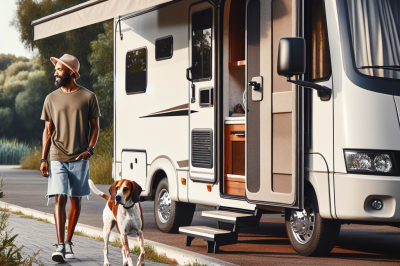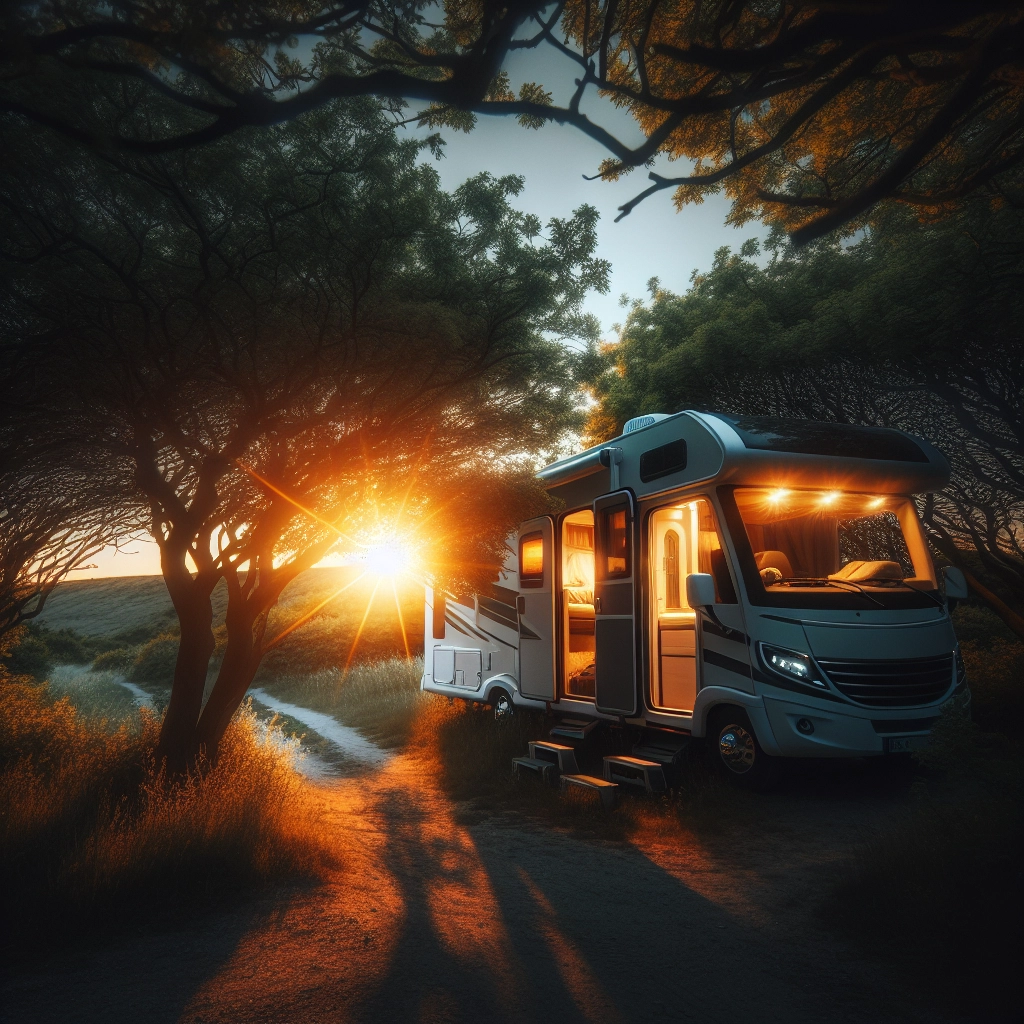Table of Contents

Shining a Light on Solar: Powering Your RV Off-Grid
Imagine the freedom of traveling the open road in your RV, with the sun as your only fuel station. Solar power has revolutionized the way RV enthusiasts explore and live off-grid, offering independence from traditional power sources. But before you can bask in the glow of your eco-friendly setup, you need to know how much solar power your RV requires. Let’s break it down.
Article-at-a-Glance
- Discover how to calculate the solar capacity needed for your RV.
- Learn to assess your energy consumption to tailor your solar setup.
- Understand the importance of sizing your solar panels for optimal power.
- Explore tools that help customize your RV’s solar system.
- Gain insights into real-world applications and how fellow RVers are harnessing the sun’s power.
The Solar Power Equation for Boondocking
Boondocking, or dry camping, is all about self-sufficiency. The key to a successful solar setup lies in balancing your energy needs with the right amount of solar input. This means calculating your daily power usage, factoring in the efficiency of your solar panels, and ensuring your battery storage is up to the task. It’s not just about installing solar panels; it’s about creating a harmonious system that keeps the lights on and your adventures rolling.
Understanding Your RV’s Energy Appetite
First things first, you’ve got to figure out how much power your RV consumes. Start by listing all your electronic devices and appliances, then note how many hours a day you use them. This will give you a rough estimate of your daily power usage. Remember, it’s better to overestimate a bit to avoid being left in the dark. And don’t forget, energy consumption can vary with the seasons and your lifestyle.
Sizing Up Solar Panels: How Much is Enough?
Now that you’ve got a handle on your power needs, it’s time to match them with the right solar panel capacity. The rule of thumb is that most RVers can get by with about 600 watts of solar power, but your mileage may vary. You’ll need to consider the efficiency of your panels and the average sunlight hours they’ll receive. It’s a bit like fitting pieces of a puzzle together until you see the full picture of your energy independence.

Tools for Tailoring Your Solar Setup
Thankfully, you don’t have to be a solar scientist to get this right. There are plenty of tools and resources available to help you tailor your solar setup. From online calculators that crunch the numbers for you to apps that track your energy consumption in real-time, these tools take the guesswork out of going solar. And if you’re the hands-on type, you can even experiment with different panel placements to see how the power output changes with the sun’s position.
Calculators and Apps to Estimate Solar Needs
Stepping into the solar arena can feel like navigating uncharted territory, but fear not. Calculators and apps are your digital compasses. These handy tools take into account your specific energy usage, the efficiency of your solar panels, and even the average sunlight in your area to provide an estimate of the solar capacity you’ll need. They’re user-friendly and can save you from costly over- or under-estimation. Just input your data, and let the tech do the heavy lifting.
Critical Components: Panels, Batteries, and Inverters
Understanding the core components of your solar setup is crucial. Solar panels are the frontline soldiers, harnessing the sun’s energy. Batteries are the storage units, holding onto that power until you need it. And inverters? They’re the translators, converting stored energy into a form that your RV can use. Each component must be selected with care to ensure they work together seamlessly, providing you with reliable power day and night.
Gauging Solar Gain: The Role of Sunlight and Location
The sun is your fuel source, and just like any fuel, the amount you can harvest varies. Solar gain is a term that refers to the amount of solar energy received by your panels. It’s influenced by factors like the time of year, weather conditions, and where you’ve parked your RV. To get the most out of your panels, you’ll want to park in a spot with maximum sun exposure, avoiding shade from trees or other obstructions.
Analyzing Sun Exposure: Peak Hours and Positioning
Not all sunlight hours are created equal. Peak sun hours are the golden window when your panels will be most effective. This is typically midday when the sun is highest in the sky. Positioning your panels to face the sun during these hours will optimize your energy harvest. Some solar enthusiasts even adjust their panels throughout the day to follow the sun’s path, squeezing out every bit of power.
Locational Latitude: Adjusting for Geographical Variance
Your geographical location plays a pivotal role in your solar setup’s efficiency. The closer you are to the equator, the more direct sunlight your panels will receive. Conversely, the farther north or south you go, the more you’ll need to compensate with additional panels or increased battery capacity. It’s all about striking a balance that suits where you are and where you’re headed.

Batteries as the Backbone
Batteries are the unsung heroes of your solar system. They store the energy your panels collect, ensuring you have power when the sun goes down or on cloudy days. The capacity of your batteries determines how long you can run your appliances and devices without a recharge. It’s essential to have enough battery storage to match your daily energy consumption, with a little extra for peace of mind.
Amp Hours Explained: The Storage Side of Solar
Think of amp hours (Ah) as the currency of battery storage. This unit measures the charge capacity of your batteries, essentially telling you how much power they can hold. A higher Ah rating means more energy at your disposal. It’s like having a bigger gas tank for longer journeys. For instance, a 100Ah battery can supply 100 amps for one hour, or 10 amps for 10 hours. When planning your solar setup, you’ll want to ensure your battery capacity meets or exceeds your daily power usage.
Balance of Power: Pairing Solar Input with Battery Capacity
Harmony between solar input and battery capacity is the sweet spot for any off-grid setup. Your solar panels may be soaking up the sun all day, but if your batteries can’t store what’s generated, it’s like pouring water into a cup with a hole in the bottom. On the flip side, having more battery storage than you can fill leaves potential on the table. The goal is to match your daily energy production with your storage capacity, so nothing goes to waste.
Dialing in Your System: Adjustments and Add-Ons
Once your solar system is up and running, you’ll likely find areas for improvement. Maybe you’ve added a new gadget to your RV, or you’re using more power than anticipated. Adjusting your system can mean adding more panels, upgrading batteries, or tweaking your energy habits. It’s a continuous process of fine-tuning to ensure your setup meets your evolving needs.
Expandability: Planning for Future Power Needs
Life changes, and so do power needs. When designing your solar system, think ahead. Will you be working from the road, requiring more power for electronics? Are you planning to add more appliances? Make sure your system has the capability to grow. This might mean installing a solar controller that can handle extra panels or choosing a battery bank that can be expanded. Future-proofing your system saves you from a complete overhaul down the line.
Efficiency Enhancements: Maximizing Energy Yield
Getting the most out of your solar setup isn’t just about adding more panels. It’s also about working smarter, not harder. There are several ways to enhance efficiency: keeping panels clean, ensuring they’re angled correctly, and avoiding shade. You can also look into MPPT (Maximum Power Point Tracking) solar charge controllers, which optimize the power output from your panels. Small tweaks can lead to significant gains in energy yield.

Real-World Rig Insights
There’s no substitute for experience. Hearing from those who’ve successfully navigated the solar setup process can provide invaluable insights. Take Mark and Sarah, for example, who’ve been boondocking full-time for three years. They started with a modest 400-watt system but found they needed more power for their laptops and camera equipment. By adding an extra 200 watts and upgrading their battery bank, they’ve found their sweet spot.
Case Studies: Boondockers Who Got It Right
Let’s talk about Jack and Diane, a couple who hit the nail on the head with their solar setup. They meticulously calculated their energy needs, accounting for everything from their LED lights to their mini-fridge. With 800 watts of solar panels and a 400Ah battery bank, they’ve been living comfortably off-grid for over a year. They even have enough power to host outdoor movie nights for fellow campers!
“We monitored our energy usage for a week and adjusted our habits. Now, our solar system covers all our needs, and we even have a surplus on sunny days!” – Jack and Diane
Stories like theirs show that with the right planning and a bit of trial and error, you can create a solar setup that’s just right for your RV lifestyle.
Common Missteps: Learning from Others’ Experiences
Now, not all stories are of seamless success. Take Bob, who underestimated his energy usage and installed a solar system that fell short. He quickly learned that skimping on battery capacity meant his lights went out sooner than expected. After a few nights without power, Bob upgraded his battery bank and added an extra panel, finally meeting his energy needs.
- Underestimating energy consumption
- Choosing the wrong battery type
- Ignoring the impact of shading on solar panels
- Forgetting to maintain and clean solar panels
- Overlooking the need for a high-quality charge controller
These common errors can be avoided by taking the time to understand your actual power needs and the nuances of solar power.
Finding Your Solar Sweet Spot
Every RV and every boondocker’s lifestyle is unique, which means there’s no one-size-fits-all solution when it comes to solar power. Finding your solar sweet spot is a personal journey. It involves understanding your energy habits, the capabilities of your RV, and the conditions you’ll be camping in. It’s a blend of practicality, foresight, and sometimes, a little bit of compromise.
Adjusting for Lifestyle: How Usage Dictates Demand
Your daily activities have a direct impact on your solar power needs. If you love to cook with electric appliances or you can’t live without your air conditioner, you’ll need a beefier setup than someone who’s happy with basic lighting and charging a phone. Reflect on your lifestyle and consider how each activity translates into power usage. It’s all about aligning your energy demands with your solar capacity.
Tips for Managing Consumption While Boondocking
Conserving energy is just as important as generating it. Here are some tips to help you manage your consumption while enjoying the boondocking life:
- Switch to LED lighting to reduce power usage.
- Use energy-efficient appliances and be mindful of usage times.
- Charge devices during peak sun hours to make the most of solar production.
- Insulate your RV to maintain comfortable temperatures with less energy.
- Consider a solar oven for cooking to save on power.
- Regularly check your system’s health to ensure peak performance.
Frequently Asked Questions (FAQ)
Small changes can have a big impact on how long your stored solar power lasts.
Remember, your solar setup is as individual as your RV journey. Embrace the learning curve, and enjoy the ride!
Do I need more solar power if I have a larger RV?
The size of your RV can influence your solar power needs, but it’s not just about square footage. What matters more is the amount and type of appliances and electronics you’re powering. A larger RV may have more amenities that require electricity, from multiple TVs to a residential fridge. So, while the size of your RV is a factor, it’s the energy consumption of your appliances and your usage habits that truly dictate your solar power requirements.
Can I use solar power for air conditioning while boondocking?
Running an air conditioner on solar power is possible, but it requires a substantial investment in your solar setup. Air conditioners are one of the most power-intensive appliances in an RV. To run one solely on solar power, you’ll need a robust system with high-capacity batteries and a significant number of solar panels. It’s essential to calculate your AC’s power draw and design your system accordingly. Many boondockers opt for alternative cooling methods or use their AC sparingly to stay within their solar system’s limits.
How do I know if I have enough solar power for my RV?
Calculate your daily power usage and compare it to the estimated output of your solar setup. If your production meets or exceeds your consumption, you’re in good shape.
What’s the best way to maintain my solar panels?
Keep them clean and free of debris. Regularly check connections and monitor the system’s energy output to ensure everything is functioning correctly.
Do I need a generator if I have solar panels?
It depends on your energy needs and setup. A generator can be a backup for days when solar production is low.
As we wrap up this solar journey, remember that your path to the perfect RV boondocking solar setup is unique. It’s a blend of careful planning, understanding your energy needs, and being prepared to adjust as those needs change. The sun is a powerful ally for the off-grid adventurer, and with the right setup, you can harness its energy to power your travels and experiences. Embrace the freedom that solar power brings to your RV lifestyle and enjoy the peace of mind that comes with sustainable, self-sufficient living.
Whether you’re a weekend warrior or a full-time boondocker, the investment in solar power pays dividends in autonomy, environmental stewardship, and the sheer joy of waking up to a new view whenever you choose. So go ahead, chart your course under the open sky, and let the sun guide you to your next adventure.
- Boondocking RVs: Flexible Solar Solutions – 3 March 2024
- Renewable Energy Tips for Full-Time Boondocking RVers – 2 March 2024
- Boondocking Solar Power Systems: Sizing Options & Solutions for Motorhomes – 1 March 2024
